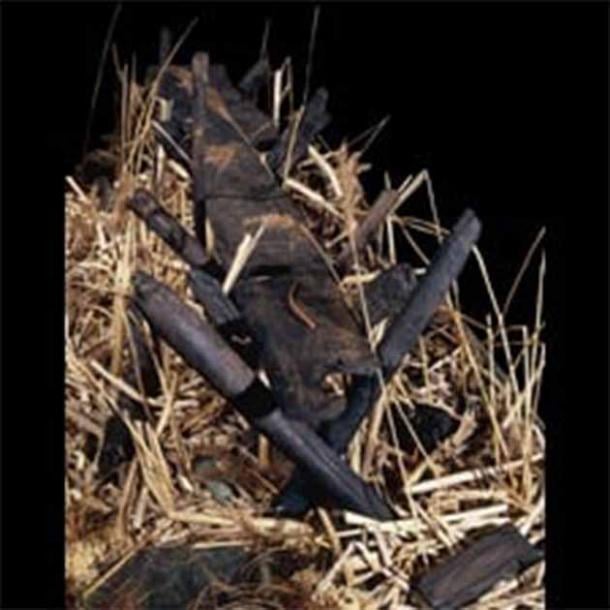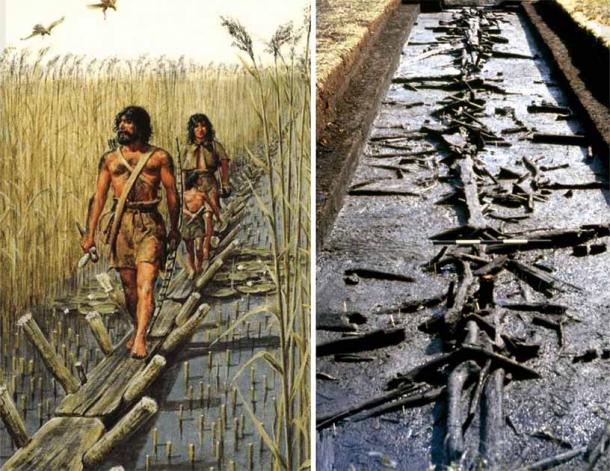We need to be doing this ourselves in order to properly penetrate working wetlands. modern design will still see a six or eight inch cedar log sawn down the center and cedar posts used to create the pegs. One can be a lot blonger to accomadate a natural railing. we will need a tie device to hold it together.
Easy and allows access into a wetland without getting your feet wet while using coppicing as well. all this accomadates direct management.
We are not there yet, but with the need to sustain beaver husbandry anyway, it becomes practical to level wetland fields for wetland crops.
Sweet Track, a 6,000-year-old Testament of Prehistoric Ingenuity
UPDATED 10 SEPTEMBER, 2023 - 14:46 ALEKSA VUČKOVIĆ
https://www.ancient-origins.net/artifacts-ancient-technology/sweet-track-0019270?utm_source=substack&utm_medium=email
Ancient history, before the major civilizations emerged, is a world full of secrets and hidden knowledge. People often have a skewed view of these periods of humanity, thinking that the people of the Stone Age were crude and primitive in every way. But archaeology teaches us something entirely different. With each new dig and discovery, we learn more and more about ancient man. We learn that these people were quite sophisticated, and capable of creating advanced things. The Sweet Track is an ideal example. An ancient trackway, it survived thousands of years even though it was made of wood. Expertly crafted, it provides an ideal glimpse into the lives of ancient communities.
Neolithic Secrets along the Sweet Track
The Sweet Track is an ancient wooden trackway, or causeway that was built during the Neolithic period in what is now Somerset, England. It is one of the oldest known engineered roads or trackways in the world, dating back to around 3807 BC, during the late Neolithic or Early Bronze Age . The trackway was discovered in 1970 during peat excavation work in the Somerset Levels, a wetland area in southwestern England.
The Sweet Track was constructed over marshy terrain to provide a reliable pathway for people to traverse the landscape, especially during periods of wet weather when the surrounding area would have been waterlogged. The trackway was made by laying down long wooden planks and linking them with interlocking wooden pegs, creating a raised pathway above the wet ground. This innovative construction technique allowed people to move more easily across the landscape, connect different areas, and potentially transport goods. A true Neolithic shortcut!

Section of the "Sweet Track" walkway From England - 3807/3806 BC, in the British Museum. (© Trustees of the British Museum/ CC BY-NC-SA 4.0 )
The name "Sweet Track" comes from the name of the peat digger who discovered it, Ray Sweet. The trackway was exceptionally well-preserved due to the waterlogged conditions of the peat bog, which prevented the wood from decaying. As a result, a significant portion of the trackway was recovered and studied by archaeologists, providing valuable insights into the technology, engineering, and daily life of the Neolithic people who built and used it.
A Path across the Marshes
The Sweet Track is an important archaeological find because it offers a glimpse into the technological capabilities of prehistoric societies and sheds light on their strategies for coping with challenging environmental conditions. It demonstrates a high level of craftsmanship and organization, as well as a sophisticated understanding of working with natural materials to create functional infrastructure.
The trackway is estimated to be around 2,000 feet (600 m) long and 4 feet (1.2 m) wide. It was constructed, as we mentioned, by using a sophisticated method that involved creating interlocking joints between the planks and using wooden pegs to hold them together. The planks were cut from local trees, most likely alder and oak, and shaped using stone tools . The builders carefully laid the planks side by side to form a stable and elevated pathway above the marshy ground. That way, the local community was spared from having to go the long route, around the marshes.
Thanks to the exceptional preservation of the wood, researchers were able to pinpoint the exact year in which the track was constructed - 3807 BC. This is all thanks to radiocarbon dating , one of the most accurate methods used today. The wood was preserved due to the acidic and anaerobic environment of the peat, which helped prevent decay. What is more, excavations of the Sweet Track site have revealed not only the trackway itself but also artifacts and organic materials associated with the people who built and used it. These findings have provided insights into the diet, tools, and daily activities of the Neolithic inhabitants of the region.Corlea Trackway Holds the Echoes of 2000-year-old Footsteps

The Sweet Track, a timber walkway once formed a network of pathways, ingeniously crafted to offer a dry route through the marshy terrain. ( Museum of Artifacts /Facebook)
Built in the Marsh, Remains in the Marsh
Taking the trackway out of the watery ground would mean its certain destruction - the air and the conditions would bring about its rapid decay. It is because of this that most of the trackway remains buried in the location it was found. That way it will remain “alive”. The same goes for several other trackways in the area, which are younger than the Sweet Track.
Today, the Sweet Track, along with other nearby wooden trackways, has been designated as a UNESCO World Heritage Site as part of the "The English Channel Prehistoric Sites" property. This recognition underscores the global significance of the Sweet Track as a testament to human ingenuity and technological advancement in ancient times.
The discovery and study of this ancient pathway have contributed to our understanding of prehistoric engineering and infrastructure. It has led to further research on ancient trackways, wooden constructions, and the ways in which early societies adapted to their environments. The trackway remains a symbol of human innovation and resilience throughout history.
Top image: The reconstructed Sweet Track is a walkway aged 5830 years, situated in England's Somerset Levels. Source: International Journal of Heritage Studies/CC BY 4.0

No comments:
Post a Comment